originally posted at https://canmom.tumblr.com/post/633334...
It’s almost halloweeeeeen!
Which means tomorrow’s Animation Night theme is going to be spooky. Spooky like this red tentacle beast…
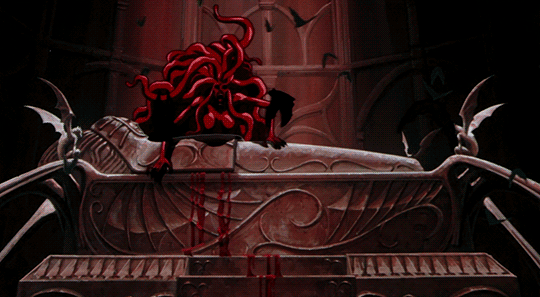
That’s right: it’s time for inducing safely simulated fear and tension as a dramatic effect, or some such overly wordy definition of ‘horror’ :p (You know what it is, though, I’m just fucking about)
Now, the first draft of this post went into a long tangent on the origins of the modern horror genre and specific characters in the gothic novel, but honestly? If you’re curious about that, I am probably not going to be able to bring you more than surface-level information.
So let’s cut it a little shorter! Naturally stories about monsters or awful events have shown up in probably any culture you could name (kaidan for example since we’re gonna be dealing with Japanese horror today); but in early modern Europe, people got into a particular way of doing that, drawing on the existing genres of romanticism and the realist modern novel.
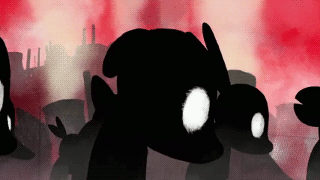
In Europe, and before long everywhere else, the 18th and 19th centuries were a time of ridiculously dramatic social upheaval - the enclosures, new science and industrial manufacturing, colonialism, witch trials - and to the newly dominant bourgeois, this period was for the creation of a ‘rational’, scientific world order in contrast to a past dominated by mysticism and magic.
So a big old portion of gothic novels fretted on the return of that scary magical old world, and attempted to cultivate an appreciation of the ‘sublime’ beyond human control, either a rebellion against the prevalent movement towards ‘realism’ or else a synthesis of the best of the old chivalric romances and the new novel. Not that Gothic novels were all about supernatural stuff; they could just as much be about a guy trying to build a dyke, or hardcore emotional drama out on a moor.
Which sometimes meant monsters! Most of the ‘canon’ of halloween monsters, from vampires and werewolves to torturers and Frankenstein’s monster, were established in the pages of Gothic novels. The monsters included stuff like scary undying aristocrats who literally sucked blood, or doctors who abused their power, or people who couldn’t trust themselves to be good rational little humans. Well, people loved that shit! So these Gothic novels were really big in the 18th and 19th centuries, which was also when everyone learned to read…
Then BAM the 20th century arrives and oh shit, we’ve invented the cinema! Horror film was pretty quick to follow; first in ‘trick films’ which experimented with spooky editing techniques (as seen above in The Haunted Curiosity Shop (1901)), such as double-exposures, attempted match cuts, objects on wires
efore long, in 1910, Mary Shelley’s Gothic novel Frankenstein (1818) got filmed and other Gothic novels like Jekyll and Hyde started seeing adaptations.
So this new genre, which became known as “horror”, turned out to be wildly popular. A full history of the horror genre and its many twists and turns would be beyond the scope of this post, but suffice to say it splintered into numerous subgenres, each concerned with particular themes, narrative devices and affects to evoke: psychological horror, splatter films, horror-comedy, zombie films… some deemed more prestigious, some less!
The popularity was surely bolstered through its complicated relationship with censorship/age restriction (nothing like banning a film to make people want to see it), and meanwhile directors would iterate on each other to chase particular tones and try to find ways to surprise people who’d seen most of their tricks… It became a pretty serious cultural force in countries like the UK and America at least, which at the same time saw gradual development of the old festival of ‘halloween’ to centre on horror-genre images and (at first home-made, then increasingly mass-produced) costumes.
(as an aside I feel like you could write a really wanky but also interesting article on how these old-school holidays of masses and handing out home-made like soul cakes became the modern version of dressing up as a vampire and asking your neighbours for branded sweets. Apparently American trick-or-treating developed in the late 20s/early 30s, but WP has little speculation as to how and why.)
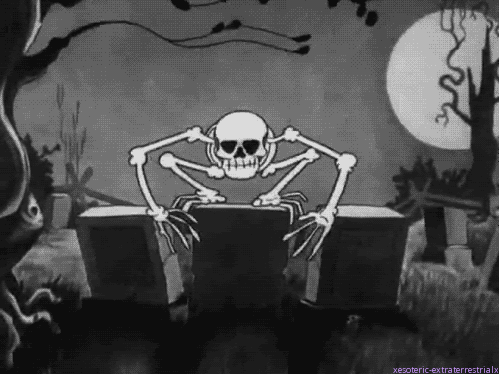
So what about ANIMATION? Well, compared to live action, horror animation seems to be a relatively small part of the genre. But it’s definitely been there! Horror-inspired images were present in some of the early animated films, such as Disney’s The Skeleton Dance (1929), which doesn’t particularly try to scare anyone, but absolutely grabs from the milieu of ‘spookiness’. And of course, Fleischer also used images of ghosts and executions and graveyards pretty heavily, including some of the ones with rotoscoped Cab Calloway performances we talked about back on #21.
There was also an early example of horror paper-cutout animation in the brief informative sections of the Swedish-Danish film Häxan (1922), attempting to illustrate the medieval worldview which the filmmaker considered to be the origin of the witch trials. This included, for example, depictions of Aristotleian cosmology:
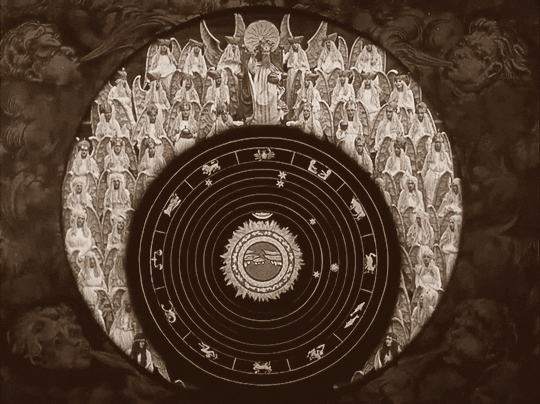
But as far as animation as like ‘serious’ horror animated films, with the actual intent to unsettle or scare or just like, at least not playing it for kitschy laughs, there are fewer examples!
The same is kinda true in Japan, in that horror anime is a relatively slim part of the whole anime corpus (wanker hand motion)… but there’s still considerably more horror anime than horror animation in other countries. And of course, developing alongside anime, was an incredible tradition of horror manga (most famously represented in the work of Junji Ito) and horror-related Japanese art movements like ero-guro (an erotic art movement emphasising shocking content like intricate body horror or in some cases sexual violence; check out the amazing work of Shintaro Kago for a fave here). Japanese live action horror films also went to some really fascinating places, such as cult-fave Tetsuo: The Iron Man.
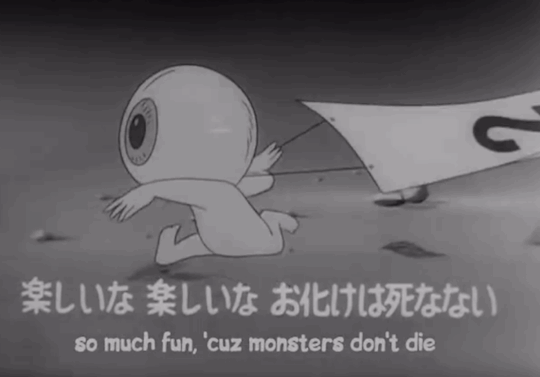
The earliest horror anime I can find is the Toei adaptation of GeGeGe no Kitarō, which widely popularised yōkai to modern audiences. This was in large part inspired by an earlier kind of street theatre called kamishibai, which used illustrated panels as a kind of slideshow; kamishibai characters influenced a fair few of the films I’m about to talk about! (Shoutout to my friend Mogs here, who streamed the OG trans woman weeb Jennifer Diane Reitz’s digital kamishibai program last year…)
In the late 80s and early 90s, there was something of a boom in horror anime OVAs and films. The most prominent studio is definitely Madhouse (the original studio of Satoshi Kon and Mamoru Hosoda, if you’re keeping track!). Madhouse produced a whole bunch of horror OVAs and films, typically directed by Yoshiaki Kawajiri - these include Bride of Deimos (1988), Demon City Shinjuku (1988), Doomed Megalopolis (1991), and Ninja Scroll (1993). Studio Pierrot also appeared around this time and made plenty of horror. Also very prominent are adaptations of the work of wildly influential mangaka Go Nagai, such as Violence Jack (1986) and especially the (slightly earlier) Devilman TV series (1972-3).
Unfortunately (for my personal taste!), as far as adaptations of ero-guro are concerned, it seems to have mostly been the rape story side of the movement rather than the cool body-horror imagery I like: you get examples like such as Shōjo Tsubaki (1992) which is a one-person limited-animation story centering on a kamishibai character, about a circus freakshow which is, behind the scenes, loaded with every paraphilia and fetish the artist could think of. Similarly, the ‘tentacle rape’ motif (that became kinda ridiculously overblown as a stereotype about anime in the West) was widely popularised by an ero-guro anime adaptation called Urotsokidōji: Legend of the Overfiend (1987-1996) (which goes way harder with that stuff than the original manga). These were outré enough to cast a really long shadow today.
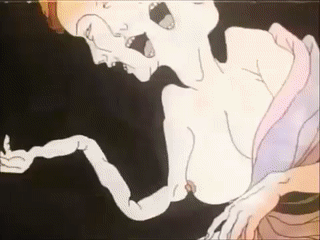
Naturally, since the 90s, there has been absolutely loads of anime that uses horror motifs, to the point that it’s kind of hard where to draw much of a meaningful line between ‘horror’ and ‘not’. Like, would Evangelion count as horror? Madoka? They’re not really seen in that light though. Still, we can pull out a few that are definitely part of The Genre!..
One prominent trend is vampire anime, exemplified by the series Vampire Hunter D, or the Madhouse project Blood: The Last Vampire, which spawned like a million sequels. For whatever reason, bloodsucking European aristos got pretty popular over in Japan! Perhaps in D’s case, that had something to do with the gorgeous manga panels drawn by Yoshitaka Amano (that guy who did so much to define Final Fantasy!), which Ashi Productions and later Madhouse did a great job adapting into the more limited format of animation cel. And for Blood, well, a girl chopping up vampires with a katana is just cool I guess.
Whatever the reason, these early vampire anime led to plenty of other vampire anime, such as Hellsing (2001) about England getting invaded by nazi vampires which I note mostly because its English dub is incredibly hammy and silly.
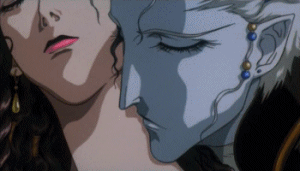
There are also a couple of striking anthology series to mention here; Yamishibai (2013-) tells a bunch of really short ghost stories in a kamishibai-inspired format, which will be watching much of tonight. There’s also jidaigeki anthology horror series Ayakashi (2006) which led to the extremely stylish spinoff Mononoke (2007-8) about a medicine seller (not to be confused with the legendary Miyazaki film!). And there’s a short CG OVA called Kakurenbo (Hide & Seek) which sports some very stylish masks and creature designs drawing on traditional Japanese festivals which we’re going to screen also…
In terms of psychological horror, Madhouse (these guys again!) went in hard adapting Monster in 2007, about a surgeon who saves a life only discover that the man he saved is a serial killer with a long career, which seems to be widely noted. And of course there are Satoshi Kon’s films: his first film Perfect Blue (1997) about an idol facing a stalker, and many episodes of his series Paranoia Agent, which tells a series of loosely connected stories about people mostly facing various kinds of mental health crises.
And as far as personal recs from friends… Made in Abyss (2017) as some of the most genuinely affecting horror in anime.
tl;dr: there’s an absolute fuckton of horror anime. Of which I can only show a little, because Western animation has also done some incredible stuff, and my friends already call me a weeb enough :p

Our main feature tonight is actually an incredible Spanish film Psiconautas, los niños olvidados (2015), directed Alberto Vásqez (and based on his own graphic novel), which was released in English as Birdboy: The Forgotten Children. It’s a beautifully illustrated, surreal story about animal people living very bleak lives on a secluded island that was devastated by an industrial accident. The adults have mostly resigned themselves to the miserable state of affairs. A few of the children, facing no future and a routine police violence, plan to try to escape the island.
The film’s title character, Birdboy, is both a social outcast and a kind of protector spirit, haunted by a demon born of grief after the cops murdered his dad. Like most of the characters, he’s getting by through taking drugs. Much like Vásquez’s amazing short film Decorado, which we watched on Spanish animation night, the film is paced initially as lots of short punchy scenes; some bleak, some funny. Though the bleak setting and slightly unsettling style could easily seem to be like a sort of shallow ‘haha mental illness and drugs’ comedy it is nothing like that, but a blistering systemic critique that’s hardcore ACAB. And the soundtrack is fucking incredible. Try and listen to it with headphones if you don’t have a bass speaker :p
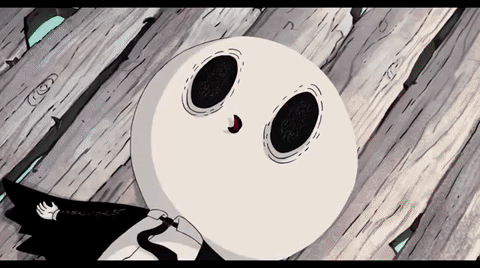
Birdboy follows an earlier short film by Vasquez in 2011, where we can see an early form of many of the ideas… but in the intervening five years we can see how much he’s tightened the themes, the editing, the general intensity of the whole thing.
So! I am absolutely stoked to share this really cool film with you all; I don’t want to say too much more because it’s best taken as a feeling, but content warning wise the main things would be like, drugs, trauma, parental abuse, dark psychedelic imagery (the above gif is p typical), police violence, occasional gore and a pretty bleak mood (but very justified I think).
Another notable spot of horror animation is the Korean Seoul Station (2016), dir. Yeon Sang-Ho, which I told everyone I was gonna show… but on consideration I’m probably not going to show because the way it handles sexual violence, sex work and such sounds, at least off the summary, a bit eh. It’s usually described as very heavy on the social commentary; the message is pretty much ‘wow this society is pretty fucking hierarchical and maybe you should stop treating homeless people like shit’ but like a lot of Korean live action film, it does that through going really hard on gore and sexual violence and such.
But while that approach can lead to some incredibly impactful films like Oldboy or The Handmaiden, in this case, I’m not sure the animation - which I’d guess is probably Toon Boom or similar software used to animate puppet rigs, because while smooth it has a weirdly mechanical quality - is up to the task of conveying that in a way that makes it meaningful and effective.
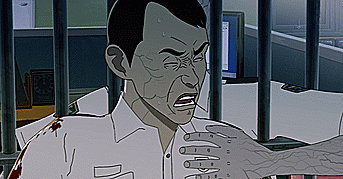
(Not to just like rip into this film I haven’t fully seen, I just wanted to mention that in case anyone’s wondering why it’s been dropped.)
Instead, I’ll be throwing in an assortment of short horror-related things. Among them I want to throw out a highlight on some web animators and student films, among them CalArts->Pixar animator David Ochs’s short film Who’s Hungry?, and independent horror animator David Romero (who’s on here at @cinemamind !). While we’re visiting America, we’ll also check out a little of Cartoon Network’s short series Over The Garden Wall (2014), which is very definitely of the post-Adventure Time milieu (complete with the slightly sardonic brown-haired boy who appeared in every mid-2010s American animation! must be friends with short-black-hair mild-mannered anime boy), but it has a decent sense of humour and some properly spooky scenes now and again.
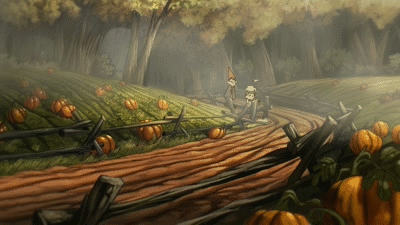
Another one I want to play again - though we saw it before in the misty past of Animation Night - is the music video to DyE’s song Fantasy, which features some splendid body horror animated by Jérémie Périn.
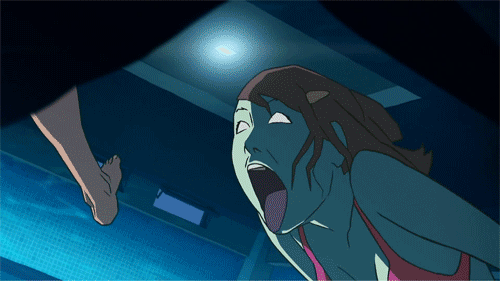
Animation Night 25 is set to begin at 7pm UK time, now just one spooky hour away, and continue until probably well past the witching hour! The haunting ground will be twitch.tv/canmom, and the playlist is portended to be:
- Yamishibai: Zanbai + The Family Rule
- Kakurenbo (Hide-and-Seek)
- Yamishibai: Umbrella Goddess + The Next Floor
- Vampire Hunter D: Bloodlust
- Intermission
- Yamishibai: Inside + The Overhead Rack
- Mushishi episode 2
- Yamishibai: Contradiction + Tormentor
- Intermission
- Midnight Snack - David Romero
- Birdboy: The Forgotten Children
- The Other Lily - David Romero
- Who’s Hungry - David Ochs
- Mon Ami qui Brille dans la Nuit - Gobelins
- DyE: Fantasy
- audience requests and music videos!
Comments